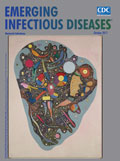
Volume 23, Number 10—October 2017
Research Letter
blaCTX-M-27–Encoding Escherichia coli Sequence Type 131 Lineage C1-M27 Clone in Clinical Isolates, Germany
On This Page
Hiren Ghosh, Swapnil Doijad, Linda Falgenhauer, Moritz Fritzenwanker, Can Imirzalioglu, and Trinad Chakraborty
Abstract
We examined extended-spectrum β-lactamase–producing isolates from livestock, humans, companion animals, food, and the environment during 2009–2016 in Germany for the presence of CTX-M-27 allele within Escherichia coli sequence type (ST) 131. E. coli ST131 C1-M27 was exclusively present in humans; its incidence increased from 0% in 2009 to 45% in 2016.
During the past 20 years, Escherichia coli sequence type (ST) 131 has emerged as a prevalent vehicle for extended-spectrum β-lactamases (ESBL) worldwide. Particularly prevalent are isolates of the clade ST131 C/H30R, which frequently are associated with urinary tract infections and bacteremia (1,2). Although the ESBL production of the predominant subgroup ST131 C2/H30Rx is conferred by the CTX-M-15 allele, the emerging subgroup C1 often is associated with other CTX-M alleles, such as CTX-M-14 and CTX-M-27 (3). An increase in C1/H30R ST131 isolates was initially reported among clinical isolates in Japan; most of those were identified as members of the recently defined clade C1-M27 (90% of C1/H30R) (3). More recently, a dramatic rise from 0% to 65% in the incidence of ST131 C1/H30R blaCTX-M-27 isolates in the fecal carriage of children in France during 2010–2015 was reported (4). In addition, ST131 isolates harboring blaCTX-M-27 have been reported sporadically from other countries (3). We examined ESBL-producing isolates from livestock, humans, companion animals, food, and the environment during 2009–2016 in Germany for the CTX-M-27 allele.
We analyzed a representative subset of 953 sequenced isolates from a collection of 4,386 nonrepetitive ESBL-producing E. coli, which were obtained through 2 national research networks investigating the incidence of antimicrobial resistance: ESBL and Fluoroquinolone Resistance in Enterobacteriaceae (RESET) and German Center for Infection Research (DZIF) in Germany (Technical Appendix 1). In silico multilocus sequence typing (MLST) identified 159 (17%) of the 953 isolates as ST131 (Technical Appendix 2). The most prevalent ESBL genes in the studied isolates were blaCTX-M-15 (73 [46%]), followed by blaCTX-M-27 (24 [15%]), blaCTX-M-1 (18 [11%]), blaCTX-M-14 (15 [9%]), and others (blaCTX-M-3/11/17/24/36/47) (10 [6%]).
Because recent reports have documented an increase in the number of C1-M27 clade isolates in Japan and France, we investigated blaCTX-M-27–encoding ST131 isolates in more detail. All ST131 isolates with blaCTX-M-27 were of serogroup O25b and harbored a fimH30 allele, except for 1 isolate that was of serogroup O16 and carried a fimH41 allele. Recently, the M27PP1 prophage-like region was defined as a specific marker for C1-M27 clade (3,4). This region was present in 23 of 24 blaCTX-M-27–harboring isolates. Phylogenomic analysis revealed that these 23 isolates belong to clade C1/H30R (Technical Appendix 2 Figure).
We identified contigs with F1:A2:B20 plasmid replicons in sequences from 20 of 24 isolates; the remaining isolates harbored contigs with F1:A6:B20, F1:A2:B20, F1:A2:B-, and F29:A-:B10 plasmid incompatibility groups. We sequenced the genome of 1 representative isolate (H105) to completion (GenBank accession numbers: chromosome, CP021454; plasmid, CP021871) and confirmed that the blaCTX-M-27–encoding contig was indeed part of a plasmid harboring the F1:A2:B20 replicon (5). This plasmid is highly conserved in isolates of ST131 and is probably ancestral to the C1/H30R clade because it is present in all the blaCTX-M-27–positive ST131 isolates, regardless of whether they harbor antimicrobial resistance genes (5).
Core genome phylogenetic comparisons of all C/H30R ST131 isolates, based on alignment to the closed genome of E. coli ST131 lineage C1-M27 isolate H105, revealed an average of 292 single-nucleotide polymorphisms (SNPs). In contrast, isolates within the C1-M27 clade were separated by <100 SNPs. Comparative analyses of 13 isolates reported from Japan showed that these isolates share ≈85% of the genome with those from Germany. Isolates from both countries exhibit an average difference of 59 SNPs, indicating clonality and possible evolution from a single common ancestor (Technical Appendix 2). Metadata of the C1-M27 isolates showed 19 of 24 isolates were obtained in 2015 and 2016, indicating recent emergence.
Our results provide evidence for the recent emergence of ST131 subgroup fimH30-O25b, clade C1-M27, harboring blaCTX-M-27, in Germany and reinforce observations made elsewhere. The data suggest an ongoing shift in CTX-M alleles associated with ST131 infections worldwide that now warrants further attention.
Mr. Ghosh is a PhD fellow at the Institute for Medical Microbiology, Justus Liebig University Faculty of Medicine. His primary research interests include investigating the transmission and epidemiology of important resistance genes and mobile genetic element using next-generation sequencing.
Acknowledgments
We thank Christina Gerstmann and Natalia Lest for excellent technical assistance and members of the RESET (http://www.reset-verbund.de/) and German Center for Infection Research (http://www.dzif.de./en/) networks consortia for providing isolates.
This study was supported by grants from the Bundesministerium für Bildung und Forschung within the framework of the RESET Research Network (contract no. 01KI1013G/01KI1313G) and the German Center for Infection Research (DZIF/grant no. 8000 701–3 Helmholtz-Zentrum für Infektionsforschung to T.C. and C.I. and TI06.001/8032808811 to T.C.).
References
- Johnson JR, Johnston B, Clabots C, Kuskowski MA, Castanheira M. Escherichia coli sequence type ST131 as the major cause of serious multidrug-resistant E. coli infections in the United States. Clin Infect Dis. 2010;51:286–94. DOIPubMed
- Petty NK, Ben Zakour NL, Stanton-Cook M, Skippington E, Totsika M, Forde BM, et al. Global dissemination of a multidrug resistant Escherichia coliclone. Proc Natl Acad Sci U S A. 2014;111:5694–9. DOIPubMed
- Matsumura Y, Pitout JDD, Gomi R, Matsuda T, Noguchi T, Yamamoto M, et al. Global Escherichia coli sequence type 131 clade with blaCTX-M-27 gene.Emerg Infect Dis. 2016;22:1900–7. DOIPubMed
- Birgy A, Bidet P, Levy C, Sobral E, Cohen R, Bonacorsi S. CTX-M-27–producing Escherichia coli of sequence type 131 and clade C1–M27, France.Emerg Infect Dis. 2017;23:885. DOIPubMed
- Johnson TJ, Danzeisen JL, Youmans B, Case K, Llop K, Munoz-Aguayo J, et al. Separate F-type plasmids have shaped the evolution of the H 30 subclone of Escherichia coli sequence type 131. mSphere. 2016;1:e00121-16.





















.jpg)












No hay comentarios:
Publicar un comentario